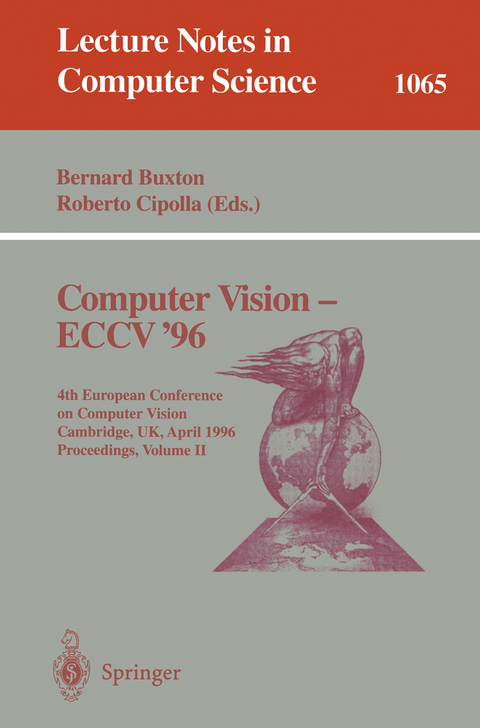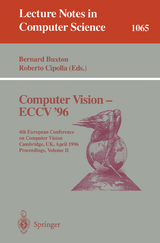Computer Vision - ECCV '96
Springer Berlin (Verlag)
978-3-540-61123-3 (ISBN)
The papers in volume II are grouped in sections on color vision and shading; image features; motion; medical applications; tracking; applications and recognition; calibration, focus, and optics; applications; and structure from motion.
Colour constancy for scenes with varying illumination.- Color angular indexing.- Bidirectional reflection distribution function expressed in terms of surface scattering modes.- Generalizing Lambert's Law for smooth surfaces.- Local scale control for edge detection and blur estimation.- Regularization, scale-space, and edge detection filters.- Direct differential range estimation using optical masks.- Generalised epipolar constraints.- Object models from contour sequences.- Directions of motion fields are hardly ever ambiguous.- Euclidean reconstruction: From paraperspective to perspective.- Optical flow and phase portrait methods for environmental satellite image sequences.- Refinement of optical flow estimation and detection of motion edges.- Reliable extraction of the camera motion using constraints on the epipole.- Accuracy vs. efficiency trade-offs in optical flow algorithms.- Rigorous bounds for two-frame structure from motion.- The rank 4 constraint in multiple (?3) view geometry.- Using singular displacements for uncalibrated monocular visual systems.- Duality of multi-point and multi-frame geometry: Fundamental shape matrices and tensors.- On the appropriateness of camera models.- Ground plane motion camera models.- Snakes and splines for tracking non-rigid heart motion.- Local quantitative measurements for cardiac motion analysis.- Application of model based image interpretation methods to diabetic neuropathy.- Global alignment of MR images using a scale based hierarchical model.- Reconstruction of blood vessel networks from x-ray projections and a vascular catalogue.- Combining multiple motion estimates for vehicle tracking.- Visual surveillance monitoring and watching.- A robust active contour model for natural scene contour extraction with automatic thresholding.- A maximum-likelihood approach to visual event classification.- Measures for silhouettes resemblance and representative silhouettes of curved objects.- Real-time lip tracking for audio-visual speech recognition applications.- Matching object models to segments from an optical flow field.- Quantification of articular cartilage from MR images using active shape models.- Direct methods for self-calibration of a moving stereo head.- Dense reconstruction by zooming.- Telecentric optics for computational vision.- Recognition, pose and tracking of modelled polyhedral objects by multi-ocular vision.- Locating objects of varying shape using statistical feature detectors.- Generation of semantic regions from image sequences.- Tracking of occluded vehicles in traffic scenes.- Imposing hard constraints on soft snakes.- X Vision: Combining image warping and geometric constraints for fast visual tracking.- Human body tracking by monocular vision.- Computational perception of scene dynamics.- A filter for visual tracking based on a stochastic model for driver behaviour.- Elastically adaptive deformable models.- Statistical feature modelling for active contours.- Motion deblurring and super-resolution from an image sequence.- Uncalibrated visual tasks via linear interaction.- Finding naked people.- Acquiring visual-motor models for precision manipulation with robot hands.- A system for reconstruction of missing data in image sequences using sampled 3D AR models and MRF motion priors.- Elimination of specular surface-reflectance using polarized and unpolarized light.- Separating real and virtual objects from their overlapping images.- Goal-directed video metrology.- Reconstructing polyhedral models of architectural scenes from photographs.- Algebraic varieties in multiple view geometry.- 3D model acquisition from extended image sequences.- Computing structure and motion of general 3D curves from monocular sequences of perspective images.- A factorization based algorithm for multi-image projective structure and motion.
| Erscheint lt. Verlag | 4.4.1996 |
|---|---|
| Reihe/Serie | Lecture Notes in Computer Science |
| Zusatzinfo | XXII, 730 p. |
| Verlagsort | Berlin |
| Sprache | englisch |
| Maße | 155 x 235 mm |
| Gewicht | 1128 g |
| Themenwelt | Informatik ► Grafik / Design ► Digitale Bildverarbeitung |
| Schlagworte | Bildverarbeitung • computer vision • Computervision • Hardcover, Softcover / Informatik, EDV/Informatik • HC/Informatik, EDV/Anwendungs-Software • HC/Informatik, EDV/Informatik • Image Processing • Mustererkennung • pattern recognition • reflection • Segmentation • Segmentierung • Shading • Stereo Vision • Stereo-Vision • Tracking |
| ISBN-10 | 3-540-61123-1 / 3540611231 |
| ISBN-13 | 978-3-540-61123-3 / 9783540611233 |
| Zustand | Neuware |
| Haben Sie eine Frage zum Produkt? |
aus dem Bereich




